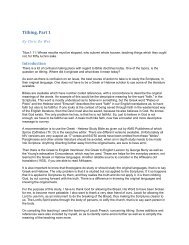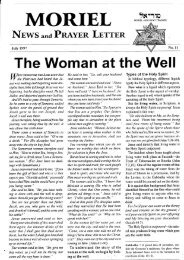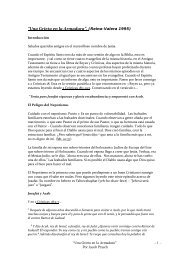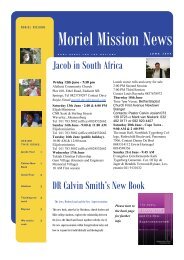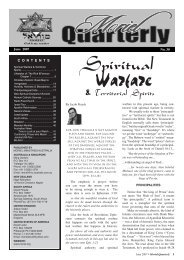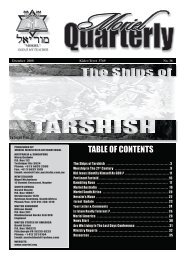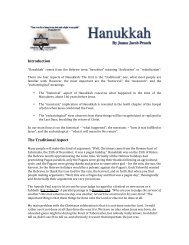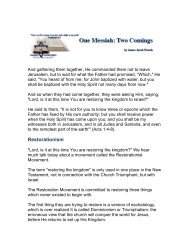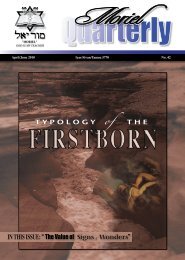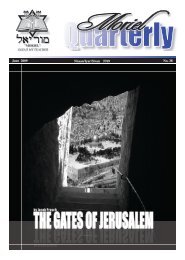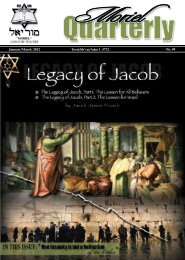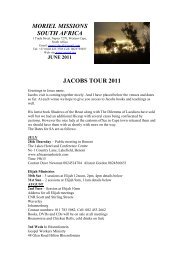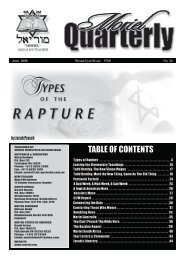The Scarlet Cord - Moriel Ministries
The Scarlet Cord - Moriel Ministries
The Scarlet Cord - Moriel Ministries
- No tags were found...
Create successful ePaper yourself
Turn your PDF publications into a flip-book with our unique Google optimized e-Paper software.
Hebrew Teaching – Continued<br />
prophetic agenda mainly on Israel and the<br />
Jews. Thus, God begins to again deal with<br />
Israel and the nations as He did in the old<br />
covenant; that is in His wrath and correction<br />
of His own people unrepentant Israel<br />
and the Jews. <strong>The</strong> shift in literary genre<br />
back to an Old Testament literary structure<br />
and character matches the divine reversion<br />
back to Israel. <strong>The</strong> church as such no longer<br />
exists after chapter 3. This is not however<br />
to place the parousia at that point (this<br />
author places that between the 6 th and 7 th<br />
seals). Neither does it deny that the Book<br />
of Revelation was written primarily for<br />
the church to understand and prepare for<br />
the future. It indeed descriptively predicts<br />
what will transpire concerning unbelieving<br />
Israel, but it is not written mainly for Israel<br />
(apart from the remnant of Jews who will<br />
turn to Christ during the time of Jacob’s<br />
trouble’). Yet clearly the eschatological<br />
emphasis in the Book of Revelation goes<br />
from being ecclesia-centric (concentrated<br />
on the church) to Judeo-centric (concentrated<br />
on the unbelieving Jews) and the<br />
switch in literary genre underscores and<br />
characterizes this transformation in God’s<br />
prophetic dealings.<br />
Even more acute from a literary perspective,<br />
however, is the Book of Revelation’s<br />
kindred textual character to the inter-testamental<br />
apocryphal books of I & II Enoch,<br />
the books of Maccabees, and the Septuagint<br />
(LXX) translation of Old Testament apocalyptic<br />
books such as Daniel, Zechariah, and<br />
Ezekiel. <strong>The</strong> Intertestamental Period and<br />
Hasmonean periods witnessed the development<br />
of apocalyptic concepts in Hebraic<br />
thought and saw the combination of Hebrew<br />
eschatological theology with Greek<br />
apocalyptic forms, minus the pagan mythology<br />
or where it was transformed into<br />
the Greek language descriptions of Old<br />
Testament concepts.<br />
Examples of this are features from the<br />
Hebrew TENAK (Torah, prophets and<br />
writings) that were related by terminology<br />
borrowed from Hellenistic eschatology<br />
such as sheol becoming hades, “Destroyer”<br />
becoming “Apollyon,” and in the Book of<br />
Daniel, the citation of animals popularly<br />
understood even in Greco-Roman culture<br />
to be metaphoric of political empires. <strong>The</strong><br />
similarities and differences (apart from the<br />
obvious monotheism) between Hebraic and<br />
Hellenistic apocalyptic is a massive subject<br />
in its own right beyond the parameters of<br />
this article. However, what we have in the<br />
Book of Revelation in essence is Old Testament<br />
Hebrew apocalyptic literature in<br />
genre translated into the Greek language<br />
written mainly for the church.<br />
We must note as believers that “all Scripture<br />
was written for us”, but “all Scripture<br />
was not written to us.” Hebrews, the Epistle<br />
of James, 1 & 2 Peter, Jude, John’s Gospel,<br />
and to a large degree Matthew’s Gospel and<br />
portions of Romans and Galatians, were all<br />
written to Jews, and it is essential for us to<br />
grasp this consideration in our reading and<br />
study of those books in order to properly<br />
comprehend under the illumination of the<br />
Holy Spirit what the content of those books<br />
means for us. Unless we comprehend what<br />
the content meant for the Jews to whom it<br />
was written, we are handicapped in correctly<br />
determining its precise meaning for<br />
us in Christ, be we Jew or non-Jew.<br />
<strong>The</strong> Book of Revelation however goes<br />
well beyond this, although it is written to<br />
the church at large consisting of both Jew<br />
and non-Jew. While it is imperative we<br />
avoid the errors of Marcionism (misreading<br />
it as a radical difference between the God<br />
of the Old Testament and <strong>The</strong> God of <strong>The</strong><br />
New) and hyper-dispensationalism (seeing<br />
the Book of Revelation as part of the<br />
Old Testament), from a literary viewpoint<br />
it must be read as we would read a Greek<br />
translation of <strong>The</strong> Old Testament yet retaining<br />
the awareness that the promised Messiah<br />
has already come but is coming again.<br />
Most of these simply draw on Old Testament<br />
references in Revelation and focally<br />
employ two of the seven midoth used by Paul<br />
in his epistles acquired from the School of<br />
Hillel, ‘Binyan Ab M’Shna Ketubim’ (deriving<br />
an interpretation from the principle<br />
that the same terms or points used by relating<br />
two kindred texts apply to all scriptural<br />
texts having the same terms and points) and<br />
Binyan Ab M’ Katub Achad (an interpretation<br />
where the principle meaning of terms<br />
in one text carries the same consideration<br />
in others texts having the same terms and<br />
points). <strong>The</strong> other five midoth are used in<br />
Revelation to a lesser degree. <strong>The</strong>se midoth<br />
existed from the early scribal era associated<br />
with the ktav tradition of the Hebrew<br />
prophet Ezra in the post captivity restoration<br />
period but were not codified and formally<br />
formulated until the time of Rabbi Hillel,<br />
the grandfather of Paul’s tutor Gamaliel.<br />
Once again, the ignorant spout religious<br />
clichés about Paul counting all things as<br />
waste after coming to faith in Christ. <strong>The</strong>y<br />
are too unlearned to read the context that<br />
he was speaking of efforts to be justified by<br />
his own righteousness under the Torah, not<br />
about his background. In the New Testament<br />
he spoke of himself in the Greek text<br />
in the present continuous active as still being<br />
a “Pharisee of the Pharisees,” not as in<br />
trying to be justified by the law but in terms<br />
of what a Pharisee meant from the Hebrew<br />
infinitive ‘L’ Paresh’, that is ‘one who interprets.’<br />
He continued to ‘L’Paresh’ after<br />
salvation—that is to say Paul continued to<br />
interpret the Word of God, and his use of<br />
midoth is evident throughout his writings.<br />
Others likewise cite Jesus’ warnings from<br />
Matthew 23 “Woe unto you Scribes and<br />
Pharisees,” omitting that Jesus also said, “I<br />
will send you scribes” (Hebrew scholars).<br />
Whenever addressing issues concerning<br />
midrashic content in the New Testament,<br />
it is essential to filter out the background<br />
noise of the ignorant babblers who misdirect<br />
others because they do not know what<br />
they are talking about.<br />
<strong>The</strong> other recurrent midrashic feature<br />
permeating the Book of Revelation is the<br />
Peshet (straightforward grammatical-historical<br />
literal or simple meaning speaking<br />
of one event) and its pesher (applied further<br />
meaning to a future prophetic event.)<br />
We see the Exodus judgments on Egypt<br />
(still commemorated in the Paschal Haggadah)<br />
recapitulated globally in the Book<br />
of Revelation: blood, darkness, frogs, etc.<br />
We see Ezekiel’s marking with the tav from<br />
Ezekiel 9:4-6 in a pesher interpretation in<br />
Revelation 7:3. Joel’s four invasions of<br />
locusts representing the four Babylonian<br />
invasions as the peshet find their pesher in<br />
Revelation 9 as the demon cohorts of hell.<br />
No place is pesher interpretation more<br />
conspicuously important in the Book of<br />
Revelation than in the eschatological recycling<br />
of Pharaoh and his magicians (identified<br />
by Paul and by Jewish historical writings<br />
as Jannes and Jambres) counterfeiting<br />
the miracles of Moses and Aaron as the<br />
antichrist and false prophet will counterfeit<br />
the miracles of Jesus and His witnesses<br />
in Revelation 13. Paul places an eschatological<br />
contrast on Pharaoh’s magicians using<br />
“Binyan Ab M’Shna Ketubim” in his<br />
teaching on the Last Days in 2 Timothy<br />
3:8. Paul tells us this will transpire again<br />
eschatologically and so, alas, in Revelation<br />
13 we see it happening.<br />
<strong>The</strong> content of the ‘Midrash of Iddo’ (2<br />
Chronicles 13:22, 2 Chronicles 24:27) is<br />
hinted at or referred to various times in other<br />
Old Testament passages revealing its content.<br />
This was known in the early church,<br />
even into the patristic era, as in Questions<br />
Hebraica by Jerome and is noted in the historical<br />
record by Flavius Josephus (Antiquities<br />
VIII .8,5).<strong>The</strong>se cite the words (dvarim)<br />
of Iddo in relation to 2 Chronicles 12:15.<br />
Of stronger note eschatologically however<br />
is the closing reference to Iddo’s visionary<br />
writings in 2 Chronicles 9:29. It is<br />
in this passage, and in its synoptic parallel<br />
in 1 Kings10, that the total number of the<br />
beast, 666, is used four times in connection<br />
with backslidden Solomon. It is used twice<br />
for the weight value of gold and twice in the<br />
architectural design of Solomon’s throne.<br />
In total, the number of the beast is used for<br />
backslidden Solomon more than with any<br />
other figure in Scripture (we examine this<br />
phenomenon in some depth in the book<br />
12 <strong>Moriel</strong> Quarterly • September 2012




